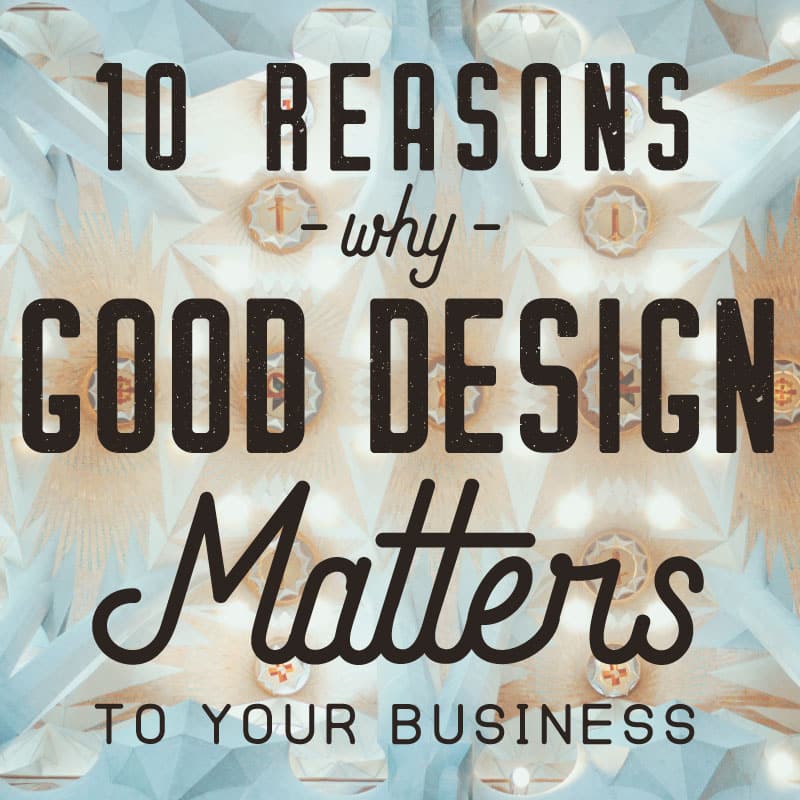If you’ve been second-guessing the value of design for your business – don’t! Good design gives you a competitive edge, drives powerful marketing results and allows you to stand out.
1. Numbers Don’t Lie: Design Sells
In short, design is fiscally beneficial. In 2005, a group called The Design Council studied 63 portfolios of companies that traded on the FTSE (Financial Times Stock Exchange) over the course of a decade. What they discovered was that the companies that put an emphasis on design did way better than the ones that didn’t – they outperformed the FTSE 100 index by 200% in fact.
A more layman-friendly figure that this study by The Design Council also determined was that “every £100 a design alert business spends on design increases turnover by £225”. So, investing in design is a bit like investing in future profits, it may cost a bit now, but a little down the track, these studies suggest that you’ll likely be glad you did so.
2. Good Web Design = Consumer Trust
Badly designed websites are often not read, trusted or visited for any length of time. Poor interface design is associated with mistrust of a website. If users don’t like the design of a site, then they typically will not explore any further than the homepage.
Now, don’t try to justify a poor website design by saying ‘at least my content is great’, because 94% of the reason users will reject a site is for design-related issues. So, your content could be stellar and as top-notch as ever, but a poor website design can bring it all to a crashing halt.
3. Good Design Makes Your Brand Memorable
What makes a brand memorable? Good customer service and a good product certainly help, but what about beyond that? Of course, it’s design.
Design techniques like a selective use of color can trigger the memory and keep your brand fresh in the mind. So, perhaps incorporating a distinct design technique like color, a unique layout, an original concept etc. can be that one added element that ensures your brand stays memorable and recognizable.
4. Well-Designed = User-Friendly
One of the major focus points of graphic design is simply to make complex information easier to digest. Technology and content are becoming ever more complex and powerful. Good design in interfaces, data display, right through to physical product design and advertisements makes it all way easier and more welcoming for the consumer.
5. Good Design Makes A Good First Impression
As a consumer you encounter hundreds upon thousands of brands, products and businesses, all competing to get your attention and convince you to buy what they’re selling. So, what’s the best way to make a good first impression? You guessed it: good design.
Studies have shown that visual appeal can be assessed within about 50 milliseconds. This boils down to the fact that designers have to make a good impression within the space of 50 milliseconds.
We’re in a world now where just about every business is online in some form, in fact encountering a business’ website is often some people’s first encounter with a business at all. This, on top of the fact that a lot of businesses now are 100% online means that the impression your website leaves is more important than ever. And how do we leave a good impression? Good design.
6. Design is More than Just How it Looks
An all too common misconception about design and designers is that design is solely about the way a product or company looks. In reality, a good designer will consider how it looks as secondary to how it works.
To break the concept of a ‘designer’ down quickly, let me just say that ‘designer’ and ‘communicator’ should be interchangeable synonyms.
A designer isn’t just going to make your website look good, they are going to consider who you are as a company, what are your values, who your audience is, what will go on your homepage, what information is most and least important to display, what the competitors in your industry are doing. They are going to pull apart your content and reassemble it in a way that helps you communicate to your audience in the best possible way.
7. Invisible Design Makes Content Shine
There’s a popular saying: “Good design is invisible”. This is the idea that design should be experienced, not noticed.
I’m sure that at one time or another you have noticed design for all the wrong reasons – pixelated images, hard to read fonts, information that is hard to follow etc. In these cases, the [bad] design is extremely visible, and users ask why the designer made those choices and they consider ways it could be done better. But, when you encounter a really great piece of design, chances are you won’t notice the design at all. Instead, you’ll consume the content easily and associate good feelings with that site or brand. Why? Because good design is invisible.
8. Consistency is Key
Consistency is arguably the key rule to a successful brand, and therefore, a successful business. An inconsistent brand is utterly forgettable. It is a simple and easily reinforced rule when you have a good, strong handle on design.
What happens when you don’t practice consistency in branding and design? Well, you’re left with inconsistency. You risk your logo being used incorrectly, your colors being loosely adapted and your audience doubting your authenticity. Using a similar color to your brand’s color seems harmless, but in the long term, little irregularities snowball and become a big problem.
9. Design Motivates People To Take Action
A call to action is a super useful tool that is given to you when you invest in producing good design. It’s not enough to engage your customers – you have to turn those clicks into sales to meet your bottom line.
Motivate your audience to take action and click that button, buy that product, share that image – whatever your goal is, convince them to take a step forward by pairing enticing type and even more enticing design.
10. Design Communicates Your Company Values & can Broaden Your Brand
The majority of your potential customers aren’t going to read your company’s mission statement, so the best way to go about communicating this is visually. Consider a way to capture your tone and values through imagery and typography and let the design do the talking.
A study by The Design Council determined that design-alert businesses are “twice as likely to have developed new products or services…” So, consider where your brand could extend to with just a few stylistic adjustments.

